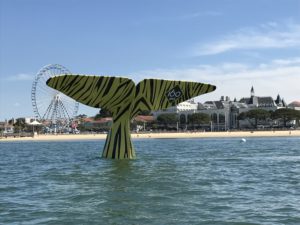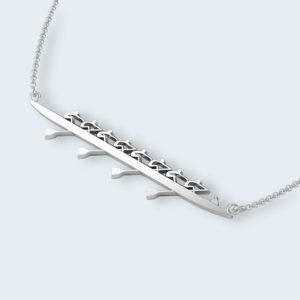How anybody can make you row faster in only 30 minutes? What is the secret?
Focus on 2 key things
There are two things that make you go faster at any given rate and both are related to your power curve or power application.
We all should know that the only thing that makes the boat go faster is the blade pushing against some water and levering yourself against the footplate in the boat.
OK let’s check what I said again here. The blade goes into the water at the catch and then through your grip and hands you lever it through the pin you are pushing some solid water against the blade. Here we have the first LEVER that is the PIN. The second LEVER or FULCRUM is the body. This lever will be the lower back and will lever your feet pushing the footplate, boat against the hands holding the oar.
OK let’s review that.
We have 2 levers here the one you will generate using your body as a lever, feet against hands getting the lower back to fulcrum and the one that the pin will do with the blade pushing water against the handle.
OK now that we know ONLY the blade pushes the boat.
How to go faster
Two things that make your blade work hard every stroke to generate more speed:
- A longer length of stroke, meaning having the blade in the water doing a longer sector/arc or a longer stroke.
- A blade that is more connected to the water, meaning that the blade will hold the water better. That will be achieved by the combination of better use of my levers and a better feel for the water.
Here’s how to set up your session
Get the rower to sit on the RP3 rowing machine and row for 5 minutes.
After that position the rower’s body better by explaining posture and showing him “hands on” moving him to change his body position and posture. Mostly this is getting the catch posture strong [shins vertical, strong core, straight back and arms not over-exended] and ensuring the rock-over at the finish brings the shoulders forward of the hips early in the recovery.
On the screen of the computer software set it to show:
- The power curve,
- Length of the stroke
- Joules per stroke.
Now set him off again at a heavier drag factor (K) rowing at 16-18 strokes per minute. This gives an easier feel for the flywheel. A heavier drag slows the wheel down and gives more time for the rower to make changes and see the impact on the power and stroke length numbers.
Let him row on for 5 to 10 minutes. Observe the rower.
If he does a good, long stroke and a good curve, tell him [you could set it as a reference curve on the software].
When they see all this data most athletes start making changes to their stroke by themselves, without your intervention. Using the direct feedback s/he starts realising what movements help get more work per stroke watching the Joules x stroke data.
That will be a longer stroke and a more powerful stroke. Obviously the more powerful stroke will be only delivered if the fulcrums or levers are fully working and connected. This is where your coaching skill is needed. Joules x stroke is the number that represents the area inside or under the curve.
So that’s 10-15 minutes rowing indoors.
The second part of the lesson
After the rower learns how to position himself, get more length out of each stroke, more connection and more power, take him onto the water and ask him to repeat the same movements in the boat. Ask him to look for the same feel of load and acceleration. The amazing thing is that the rower can really take the feel of the objective changes from the land to the water and actually make some changes for the better.
What you should coach
Here are some key elements that will help you to get a better length of stroke and connection to the water:
- Good hang on the lats with extended arms if possible.
- Good body posture sitting up especially on the recovery after rock-over and at the catch
- Good hip rotation
- Good timing at the catch to load the blade before the legs go down.
Try it, please let us know how you get on.








This Post Has 8 Comments
As a Physics teacher and rowing coach, I can’t understand your description of “LEVERS”
A rowing boat is “levered” along with the BLADE as the fulcrum, the force moving the boat is at the PIN and the applied force is on the oar handle.
The blade needs to “lock up” in the water and this occurs from a combination of moving a pile of water and a “lift’ effect generated by the shape of the blade as it moves sideways to the motion of the boat as it swings through its arc…vortex edges and blade curvature enhance this effect.
I don’t comprehend how the body is described as both a LEVER and a FULCRUM…….except that all body movement is done by levers…..a general statement……joints are the fulcrum places, muscles can only pull and move the bones into new positions.
A longer length of stroke will only help if the length was too short…..an optimum length gives the best result and any length beyond that is counterproductive (ie slows the boat).
Most crews work around a 90 to 95 degree arc, and how this is divided relative to “square off” has a big effect on how fast the boat moves…partly due to how quickly the blade achieves “lock up”…..blades that are slower to lock up due to their design or due to rowers ability need a bigger angle at the catch to compensate. The finish angle is basically fixed by the finish position.
Ideally, the peak of the power curve matches the part of the arc of the oar before and up to “square off”….and moving the catch angle will benefit if it achieves this. Too long a stroke makes this difficult, and also makes it difficult for the rower to achieve maximum power.
The position of the body at “lock up” is what matters….not its position when the blade enters the water….there is a time difference and the body is moving, so its position changes between blade entry and lock up.
Ergs reward length of stroke in a way unrelated to fast rowing….hence the exaggerated lie down finishes seen at times in the USA and Canada ….gives the better raw erg scores but won’t move a boat….hence the danger of using raw erg scores as a selection tool…especially if the selector doesn’t watch the erg test being done….good score but bad technique should be counted against the rower rather than being rewarded.
Enough for now…we need to discuss this some time.
Peter
PS….the offer for you to have your products on display at any of the Coaching courses i will be organising for RowingNZ still stands…no charge.
All good stuff from Pete.
Rebecca you need to sort your fulcrums from your levers!
I’m sure it’s the case that rowing too short is far more prevalent than too long, so 90% of the time if you can persuade a rower to row longer and achieve a quick ‘lock up’ they will go faster. In some cases it might only take 30mins, in others 30 years might be closer to the mark!
JY I stand corrected! My A-level physics was a LOOONNNGGG time ago!
Hey Rebecca,
From school and club development level I’ll still give you an A+, I glossed over the Levers & Fulcrum references but understood your overall meaning very well.
I would like to see some comparisons in regard to optimum angle of the hands at catch in relation to the gate if such data is out there?
Regards Glenn
Hi Glenn,
Firstly it sounds as if you are doing a great job; all those kids! I have just sent a blog piece to our host(ess?) Rebecca with some answers to your questions. At the level of your athletes I believe the exact angle reached is less important than the crew all reaching similar angles and the emphasis being on getting the blade into the water at this point.
Regards
Duncan
The variables that affect the power of a full stroke historicallly include the gearing ratio, the angle of the BIW line (blade in water) to the water and/or to the rowers. the relative reach of the rower depending upon type stroke, and the length of the stroke in the water. Most of these are fixed in modern boat styles.
Once upon a time, not too long ago, warships were rowed/
Rebecca, A note on levers and rowing. The rowing stroke primarily employs a second class lever. Unlike a first class lever (consider a teeter-totter) where the fulcrum is between the applied force and the load, the fulcrum in the rowing stroke is at the blade, the applied force is in the hands and the load is at the pin. This reality is why there has been so much effort in the design of the blade to minimize “slip.” With a great catch, we lock the blade in the water to create a solid fulcrum, apply force to the handle and thereby put pressure/load on the pin. Embracing this reality, makes changes in the length, inboard and outboard dimensions of the oar more easily understood.
BTW the body of the rower is a class 2 lever too. The hips are the fulcrum,
Hello, Rebecca, You are doing a great job, BUT, as your previous contacts tell you, your physics definitions are somewhat astray. A fulcrum is a POINT about which levers turn. A lever is a device that links the APPLIED FORCE to the fulcrum, eg hands to pin, or shoulders to hip ( ie the scull handle or the torso ) Have a look at my Ball Cup essays of yesteryear. No copyright for you -you are doing a great job !